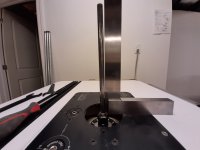Steve1
Member
Took me a while to figure out why my miters were open. The bevel cutter I used was as close to 45 (or 90) as I am able to measure.
I have a Jessem router lift which I had always considered to be very well made. But I find that if you are holding the motor a little cocked when you clamp it, it will stay cocked after you clamp it. I have one router and sometimes use it in the router table, sometimes on the fixed base, and sometimes on the plunge base. (Maybe I should dedicate a motor to the table ?) It is indeed awkward to remove/install the motor from the underside of the router table, and the clamp screw on the back. Probably I should have removed the router lift from the table and installed the motor on my workbench. I never thought to check if the spindle was actually square to the table. Live and learn. But that's also why I am writing this --- so others might not have to learn the hard way.
I have a Jessem router lift which I had always considered to be very well made. But I find that if you are holding the motor a little cocked when you clamp it, it will stay cocked after you clamp it. I have one router and sometimes use it in the router table, sometimes on the fixed base, and sometimes on the plunge base. (Maybe I should dedicate a motor to the table ?) It is indeed awkward to remove/install the motor from the underside of the router table, and the clamp screw on the back. Probably I should have removed the router lift from the table and installed the motor on my workbench. I never thought to check if the spindle was actually square to the table. Live and learn. But that's also why I am writing this --- so others might not have to learn the hard way.

